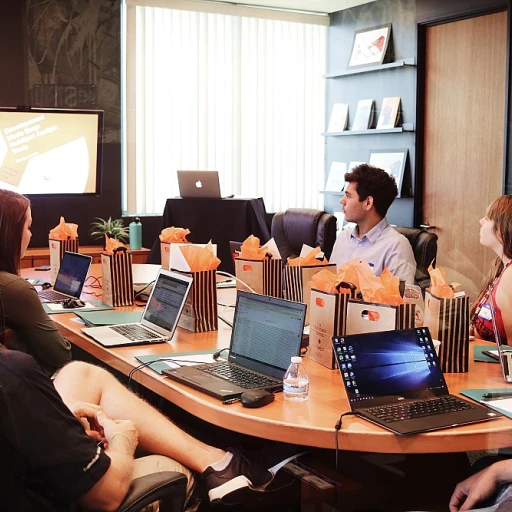
Understanding the Role of an Employee Engagement Committee
Defining the Purpose and Importance
The modern workplace thrives on collaboration and a positive work environment, making employee engagement committees vital for fostering a healthy organizational culture. These committees create and sustain engagement initiatives that align with the company's goals. By understanding their role, organizations can set the foundation for effective employee engagement. An employee engagement committee acts as the bridge between the employees and management, ensuring open channels of communication and collecting valuable feedback. This helps employees feel valued and contributes to their job satisfaction. The committee members, often representing a cross-section of the organization, take the lead in crafting and implementing engagement strategies. A well-functioning engagement committee also promotes work-life balance by designing programs that address diverse interests and needs. They spearhead team-building activities and recognition programs that boost employee satisfaction and cultivate a more engaged workforce. In understanding their role, it’s essential to see how engagement committees directly influence workplace culture. By driving initiatives that echo the company’s core values, these committees play a critical role in enhancing employee collaboration and fostering a supportive community. Ultimately, the presence of such committees is instrumental in cultivating an environment where employees feel engaged and motivated. For more insights, check out this article on crafting job ads that captivate top talent, which provides valuable information on enhancing workplace dynamics.Key Benefits of Implementing an Employee Engagement Committee
Unlocking the Advantages of an Engaged Workforce
Employee engagement committees play a vital role in transforming workplace culture. When effectively implemented, these committees create a positive work environment that encourages employees to feel valued and motivated. Here, we explore the key benefits of having an employee engagement committee.- Boosting Employee Satisfaction and Job Fulfillment: By organizing engagement initiatives and programs, committees contribute to enhancing job satisfaction among employees. Feeling appreciated leads to a sense of accomplishment and a stronger commitment to the organization's objectives.
- Promoting Open Feedback and Communication: Engagement committees provide a platform for employees to express their opinions and suggestions, fostering a culture of transparency. This proactive approach helps in identifying areas for improvement and implementing constructive changes.
- Facilitating Cross-Department Collaboration: These committees encourage collaboration between different teams, breaking down silos and ensuring seamless communication. By bringing together diverse skill sets, organizations can achieve collective goals more efficiently.
- Enhancing Employee Recognition: Recognition programs initiated by the committee help to acknowledge and reward employees' contributions. When employees feel recognized, they are more likely to stay engaged and committed to the company.
- Improving Work-Life Balance: Engagement committees often develop initiatives that focus on creating a better work-life balance, ensuring employees maintain a healthy relationship between their personal and professional lives.
Steps to Establish an Effective Employee Engagement Committee
Creating a Structure for Success
Establishing an effective employee engagement committee requires foresight and strategic planning. It's not just about assembling a group; it’s about shaping a dynamic force that fosters workplace culture and enhances job satisfaction. Here are crucial steps to develop an impactful team of engagement champions:- Define Clear Goals and Objectives: The committee should have a clear purpose that aligns with the organization's broader mission. Setting effective developmental goals in the workplace is crucial to ensuring that all efforts are focused and meaningful.
- Choose Diverse Membership: Engage employees from various departments and roles to cover a wide array of perspectives. A well-rounded team not only enhances creativity and ensures collaboration but also helps in representing different facets of work life within the company.
- Develop a Framework: Establish a schedule, define roles, and set guidelines for the committee’s operations. Flexibility in the framework allows committee members to adapt initiatives to the evolving needs of employees.
- Foster Open Communication: Encourage a culture where committee members and other employees feel valued and are comfortable sharing ideas and feedback. This builds trust and enhances engagement efforts.
- Implement Engagement Programs: Design programs and initiatives that target specific employee engagement strategies. These might include recognition programs, team building activities, or workshops aimed at improving work life balance.
- Regular Evaluation and Feedback: Continually assess the effectiveness of the committee’s initiatives by gathering feedback. This ensures the committee’s efforts are aligned with employee satisfaction and engagement goals.
Challenges and Solutions in Managing an Employee Engagement Committee
Overcoming Challenges in Managing Engagement Committees
Effectively managing an employee engagement committee involves navigating a myriad of challenges that can impact both the committee's operations and the overall workplace culture. Here are some common challenges and their solutions: 1. Balancing Work Life and Committee Responsibilities One of the main concerns is ensuring that committee members are able to balance their work responsibilities with the demands of participating in engagement initiatives. To address this, organizations can:- Allocate specific times and resources for committee meetings and activities, ensuring that these do not disrupt regular work tasks.
- Encourage managers to support their team members in various committee roles by recognizing their contributions as part of their job performance.
- Select committee members from different levels, departments, and backgrounds to promote diverse perspectives.
- Rotate committee membership regularly to ensure fresh ideas and involvement across the company.
- Clearly defining the committee's mission and objectives, and communicating these to all employees.
- Implementing robust feedback mechanisms to gauge employee satisfaction and adapt engagement strategies accordingly.
- Set measurable goals and regularly review progress through qualitative and quantitative metrics.
- Use tools like employee surveys, focus groups, and regular feedback loops to adjust strategies as necessary.
- Keep open lines of communication between committee members and company leadership to ensure alignment with evolving company goals.
- Be adaptable. Committees should be prepared to pivot strategies in response to changes in the organization's objectives.
Measuring the Impact of an Employee Engagement Committee
Evaluating the Effectiveness of Engagement Initiatives
Measuring the impact of an Employee Engagement Committee is crucial to understanding its contribution to the workplace culture. This evaluation process goes beyond quantifying employee satisfaction and delves into the core aspects of employee engagement such as job satisfaction, work-life balance, and team collaboration. Firstly, gathering employee feedback is imperative. Regular surveys and anonymous feedback forms can provide insights into how employees feel about the engagement initiatives introduced by the committee. This feedback is vital for ensuring employees feel valued and can highlight areas that need improvement. Additionally, look at the participation rates in engagement programs. High participation generally indicates that employees are engaged and finding value in the initiatives. Tracking these numbers over time can reveal trends and help committee members refine their strategies. Another effective measure is observing changes in workplace dynamics. Engaged employees typically exhibit higher productivity, motivation, and collaboration with colleagues. Such positive changes in the work environment could be attributed to the efforts of the engagement committee. Consider also the turnover rates within the organization. Lower turnover could suggest that employee engagement initiatives are successfully increasing employee satisfaction and meeting employees' needs for a positive work environment. Implementing regular reviews of committee-led initiatives is important to keep the engagement efforts aligned with the evolving goals of the organization. This continuous monitoring ensures that the committee’s objectives support the broader organizational culture, creating lasting improvements in the work environment.Real-Life Examples of Successful Employee Engagement Committees
Case Study: Tech Innovators Inc.
Tech Innovators Inc. is a prime example of how an employee engagement committee can transform workplace culture. The company established its committee to address declining employee satisfaction and engagement levels. By focusing on creating a positive work environment, the committee implemented several engagement initiatives, including regular feedback sessions and team-building activities. These efforts ensured employees feel valued and heard, significantly boosting job satisfaction and overall morale.
Success Story: Green Energy Solutions
Green Energy Solutions took a unique approach by integrating their employee engagement committee into their sustainability goals. The committee members collaborated with various departments to create programs that not only engaged employees but also aligned with the company's environmental objectives. This dual focus helped employees feel more connected to the company's mission, enhancing both engagement and organizational commitment.
Example: Financial Services Group
In the financial sector, Financial Services Group faced challenges in maintaining work-life balance for their employees. Their engagement committee tackled this by introducing flexible work arrangements and recognition programs. These initiatives were designed to improve employee satisfaction and ensure a more balanced work life. The committee's proactive strategies led to a noticeable increase in employee engagement and retention rates.
Lessons from Retail Giants
Retail Giants, a major player in the retail industry, leveraged their employee engagement committee to foster a culture of collaboration and innovation. By setting clear goals and regularly measuring the impact of their engagement efforts, the committee was able to adapt and refine their strategies effectively. This approach not only improved workplace dynamics but also resulted in a more engaged workforce, driving the company’s success.













